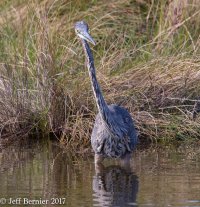So, more stuff to report.
First, the 1.4 III teleconverter is not really a solution for birds in flight, in my opinion, at least not on 6DII. Maybe it would work better on a 5DIV; I didn't have one to try.
At F8, the 6DII's autofocus is just too slow, even in full daylight. It
works, but even more poorly than 600mm/6.3 on the Sigma. If you have a slow, gently gliding big bird, you get the odd focused shot in, but generally, both are pretty terrible, compared to 400mm at 5.6, which is instant AF. The worst is when it doesn't lock, and hunts for a couple of seconds.
The solution I ended up packing was 6D2 with 100-400 II on a blackrapid for handheld shots (but with an arca plate in case I wanted to put it on a tripod), and 80D with 150-600 C in a small Thinktank backpack that I'd take out and set up when I wanted a long distance shot. For a tripod, I settled on using a Manfrotto 190 Go 4-section, with a Movo gimbal as a compromise between weight and stability, but most importantly because the maximum height between column down and column halfway up is the perfect height for me when I have a large head installed.
On my outing, I was hunting for shots of the Great Blue Heron, at a lake.
I managed to catch a few good shots with the 100-400 II, handheld:
I took this one on the tripod with the 100-400 II:
However, there were some cases where the subject was just way too far away. For example, there was a cool rock, but unless I could walk on water (boats aren't allowed), I wasn't going to get close enough for 400mm. I took this one at the full length of 600mm on an APSC:
I would like to mention that on that particular picture, I got maybe 5 keepers out of 50 shots. Most of them had a very undesirable white softness around the head of the subject. They were manually focused in liveview x 10, and once again, I'd like to whine about how sticky the focus ring of the Sigma is. They were also all taken with a remote trigger, and I would watch through the viewfinder or through liveview magnification to ensure that there were no jitters, and I took shots at everything from 1/100 to 1/4000, with apertures ranging from 6.3 to 11, and a whole bunch of ISOs.
The shots I liked best were taken at around 1/500, f9, ISO 400; TTL metering said I was at -1EV.
One last point. After trying many exposure combinations, I really hate pictures taken on the 80D over ISO 800. They are just so grainy Really, ISO 500 is as far as I'd go to keep the image sharp and clean; ISO 400 or lower being ideal.
Conclusion from the day of shooting... I really like the 100-400L II, but I didn't get a single, bird in flight keeper with the extender on it. I think that realistically, for now, if I want 600mm APSC and fast autofocus, it will require big bucks and a prime.
The 150-500C is still a great tool, with excellent reach, and stopped down a little, it takes great pictures.
I will keep both!









